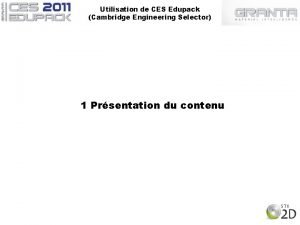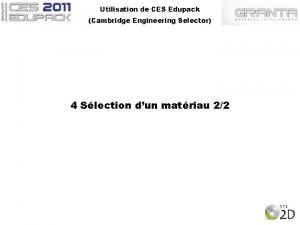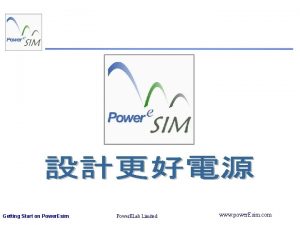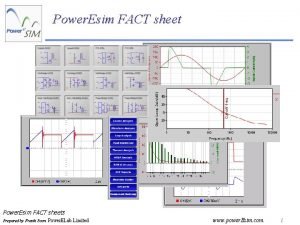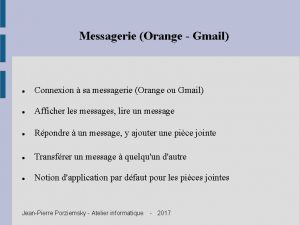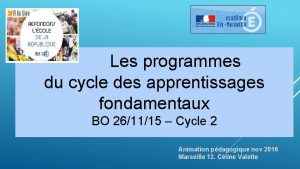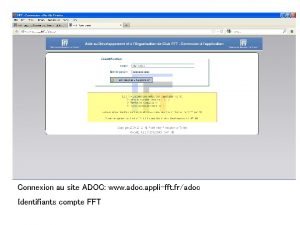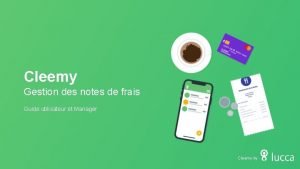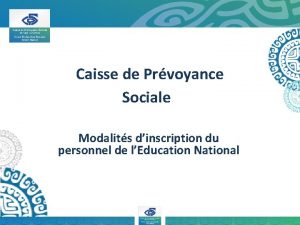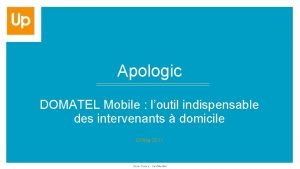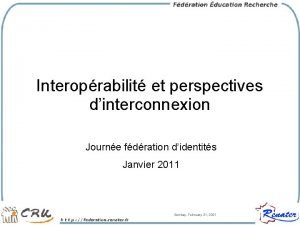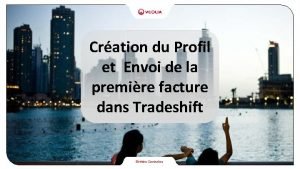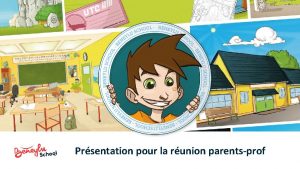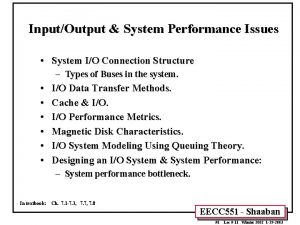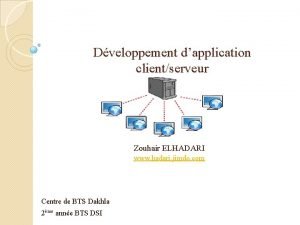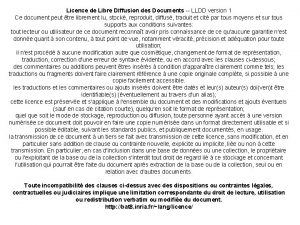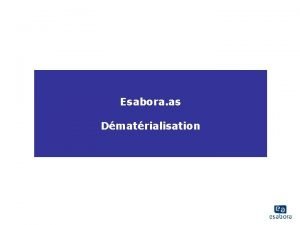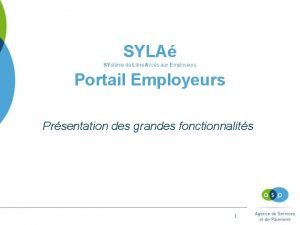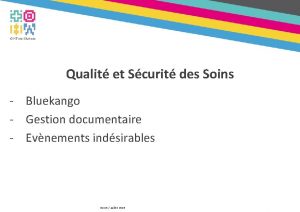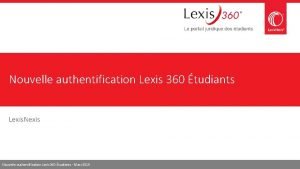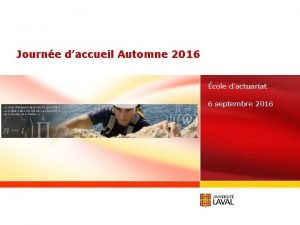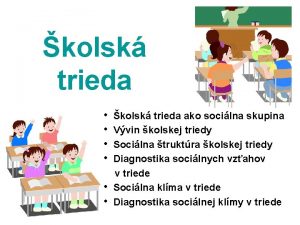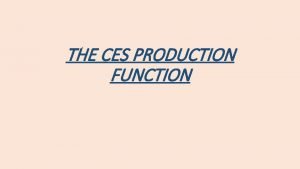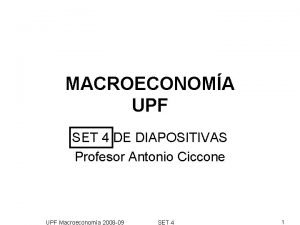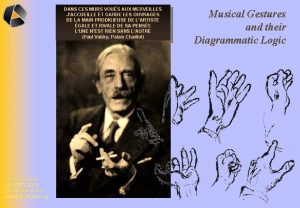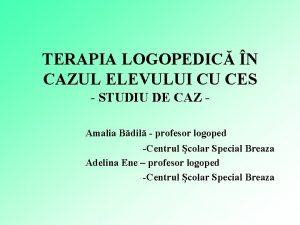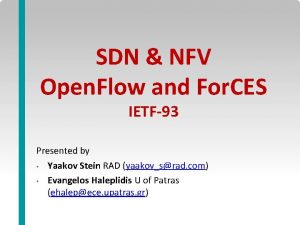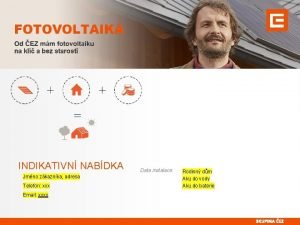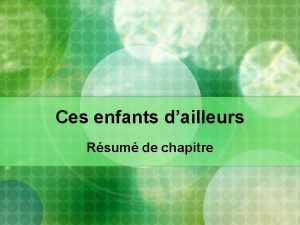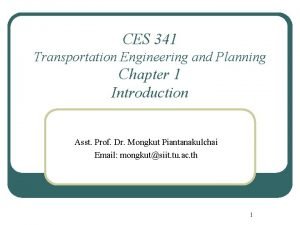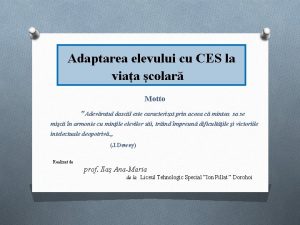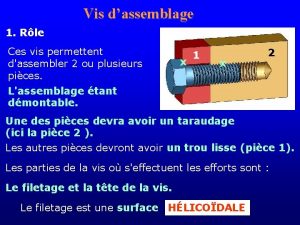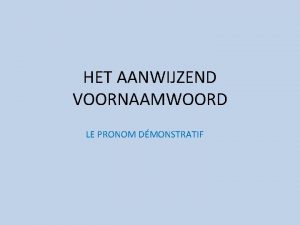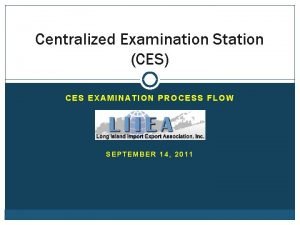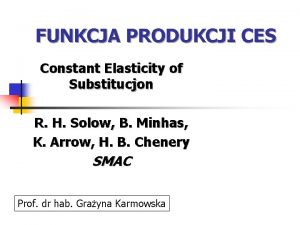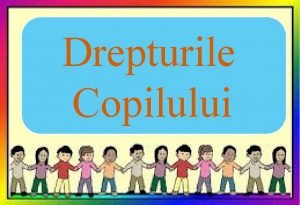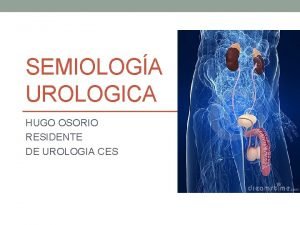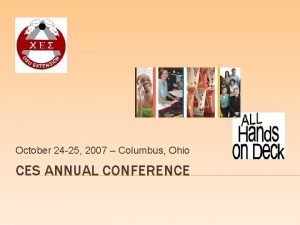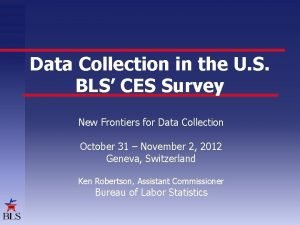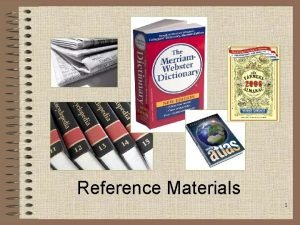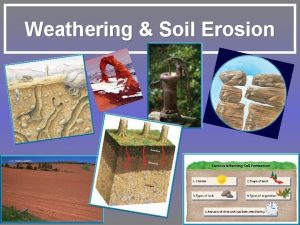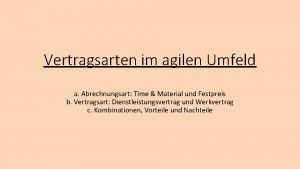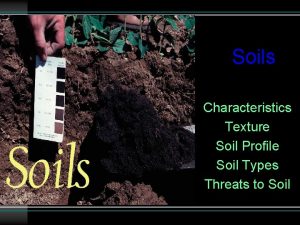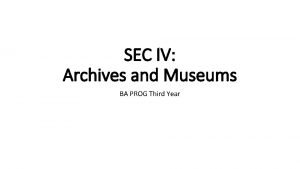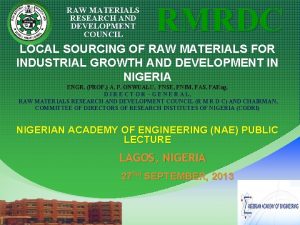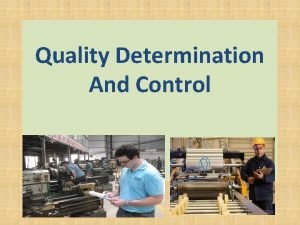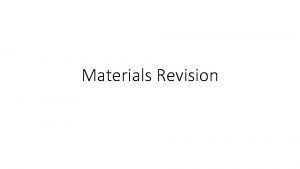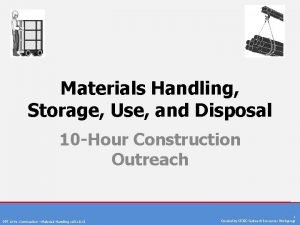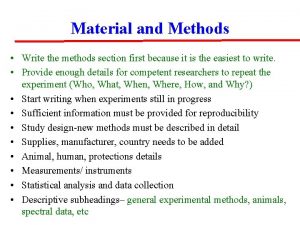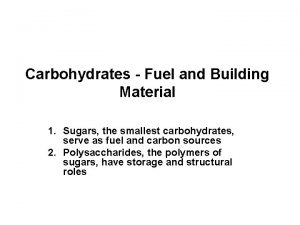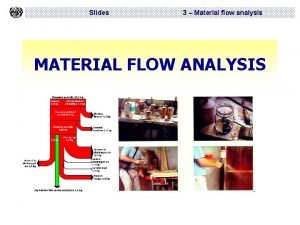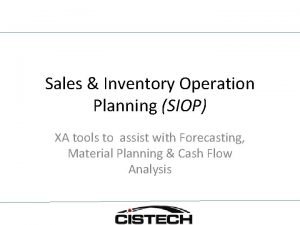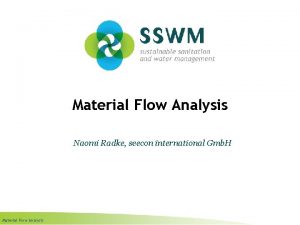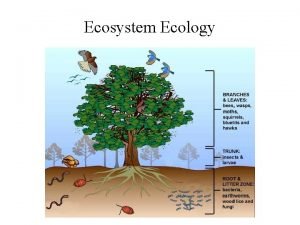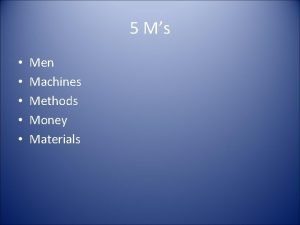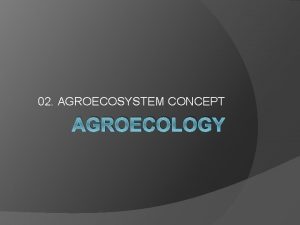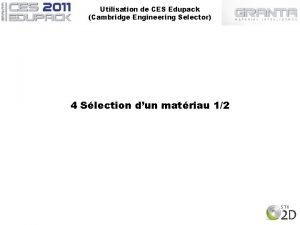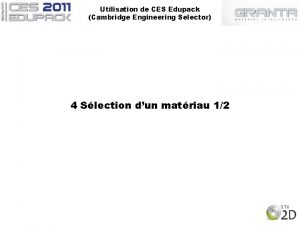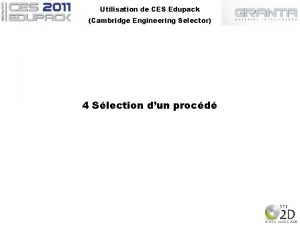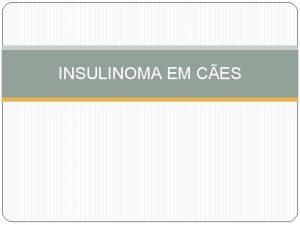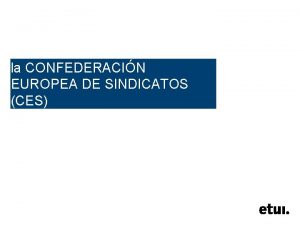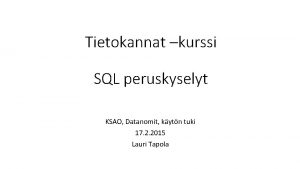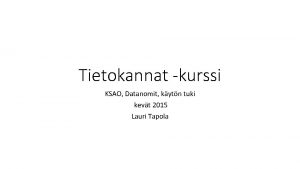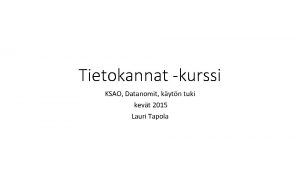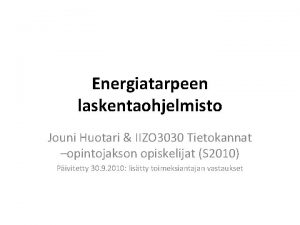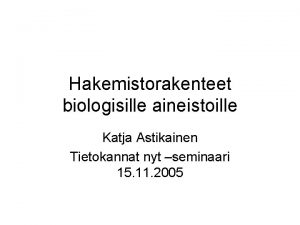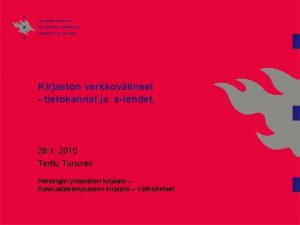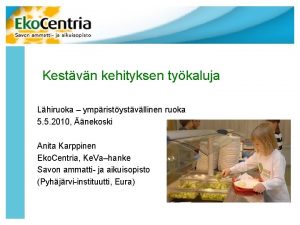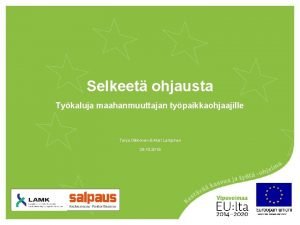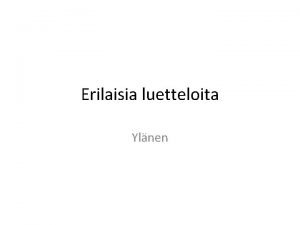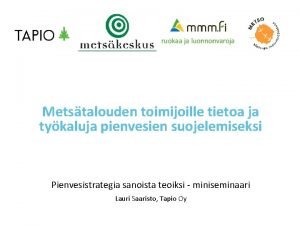CES Edupack and Material Connexion Tykaluja Tietokannat esim












































































- Slides: 76

CES Edupack and Material Connexion

Työkaluja: Tietokannat, esim. Material Conne. Xion (kirjaston kautta)

CES Edupack, in Aalto computers

Material Universe Two main approaches in teaching material sciences: Science-driven & design-driven. Design-driven begins with specification of design requirements and translation into material choices. In sustainable design it is also important to assess impacts of existing material choices in product design. Source: Edupack 2009 Manual

Material Universe Materials selection: Impacts assessment:

Material Universe In the CES Edupack database there are several datasheets, regarding: Material Universe Process Universe Legislation & regulations Nations of The World Producers

Material Universe The menu of engineering materials. The basic families of metals, ceramics, glasses, polymers and elastomers can be combined in various geometries to create hybrids. Source: Ashby & Cebon (2007) Teaching Engineering Materials

Taxonomies in Material Universe datatables: A hierarchical structure for process classification, ending with a schematic of a record. Source: Edupack 2009 Manual

Taxonomies in Process Universe data-tables: A hierarchical structure for process classification, ending with a schematic of a record. Source: Ashby & Cebon (2007) Teaching Engineering Materials

Data table record sheets Source: Ashby (2013) CES Edupack tutorial

Data-tables to assist sustainable design process: Source: Ashby et al. (2012) Materials & SD

25. 12. 2021 12

Science notes:

Data-tables to assist sustainable design process: Source: Ashby (2013) CES Edupack tutorial

Each of the three levels can be interrogated by BROWSING Exploring the database and retrieving records via a hierarchical index. SEARCHING Finding information via a full-text search of records. SELECTION Using the powerful selection engine to find records that meet an array of design criteria. And several interrogations can be combined into a single project… Source: Ashby et al. (2012) Materials & SD

CES Edupack interface:

CES Edupack interface:

CES Edupack: Material Selection

Material selection strategies § Assemble data for the characteristics of the thing you want to select; make a database, mental or physical. § Formulate the characteristics that the thing must have to satisfy your requirement; list the constraints. § Decide on the ranking criterion you will use to decide which, of the candidate things that meet all the constraints, is the best; choose and apply the objective. § Research the top-ranked candidates more fully to satisfy yourself that nothing has been overlooked; seek documentation. SOURCE: Ashby, M. (2009) Materials and the Environment: Eco-Informed Material Choice. Oxford: Elsevier.

Four steps: 1. Translation, 2. Screening, 3. Ranking, and 4. Documentation Source: Ashby & Cebon (2007) Teaching Engineering Materials Material selection process in CES Edupack:

Material selection strategies ⇒ Step one: translation - converting the design requirements into a prescription for selecting a material and a process to shape it. Source: Ashby & Cebon (2007) Teaching Engineering Materials

Selection strategies Þ Step two: screening - eliminating the candidates that cannot do the job because one or more of their attributes lies outsides the limits set by the constraints Common constraints, e. g. : Must be: Electrically conducting Optically transparent Corrosion resistant Nontoxic Nonrestricted substance Able to be recycled Must meet a target value of: Stiffness Strength Fracture toughness Thermal conductivity Service temperature SOURCE: Ashby, M. (2009) Materials and the Environment: Eco-Informed Material Choice. Oxford: Elsevier.

Selection strategies Þ Step three: ranking - ordering the survivors by their ability to meet a criterion of excellence, such as minimizing cost, embodied energy, or carbon footprint - the property or property-group that maximizes performance for a given design is called its material index Common objectives: Minimize: Cost Mass Volume Thermal losses Electrical losses Energy consumption Carbon emissions Waste Environmental impact Resource depletion SOURCE: Ashby, M. (2009) Materials and the Environment: Eco-Informed Material Choice. Oxford: Elsevier.

Selection strategies Þ Step four: documentation - exploring the most promising candidates in depth, examining how they are used at present, case histories of failures and how best to design with them - any hidden weaknesses? - what is its reputation? - has it got a good track record? SOURCE: Ashby, M. (2009) Materials and the Environment: Eco-Informed Material Choice. Oxford: Elsevier.

Using CES Edupack: Material selection

Standard and graph stage toolbars:

BROWSE, SEARCH and SELECT materials: GRAPH, LIMIT and TREE stages:

Exercises #1 BROWSING and SEARCHING Using CES Edu. Pack Levels 1 & 2

Exercise 1: BROWSE Materials • Find record for STAINLESS STEEL (LEVEL 1) • Find record for CONCRETE • Find record for POLYPROPYLENE • Find PROCESSES that can shape POLYPROPYLENE using the LINK at the bottom of the record • Explore POLYPROPYLENE record at LEVEL 2 – What else can be found?

Exercise 2: BROWSE processes Select LEVEL 2, ALL PROCESSES • Find record for INJECTION MOLDING • Find record for LASER SURFACE HARDENING • Find record for FRICTION WELDING (METALS) • Find MATERIALS that can be DIE CAST, using the LINK at the bottom of the record for DIE CASTING

• • • Exercise 3: Applying SEARCH Find the material POLYLACTIDE Find materials for CUTTING TOOLS Find the process RTM

Exercises #2 PROPERTY CHARTS Using CES Edu. Pack Levels 1 & 2

Exercise 4: Making PROPERTY CHARTS • • SELECT Material. Universe: LEVEL 2, MATERIALS Make a BAR CHART of YOUNG’S MODULUS (E) – • Make a BUBBLE CHART of YOUNG’S MODULUS (E) VS. DENSITY (ρ) – – • Set only y-axis Set both x-axis and y-axis Materials can be labeled – click and drag to move the labels; use DEL to delete a label Finally, DELETE THE STAGE (Right click on stage in Selection Stages and select “Delete”)

Charts with one – two axes & logarithmic scales:

Exercise 5: Selection using a LIMIT stage • Find materials with: MAX. SERVICE TEMPERATURE > 200 °C THERMAL CONDUCTIVITY > 25 W/m. °C ELECTRICAL CONDUCTOR OR INSULATOR? = GOOD INSULATOR – • Enter the limits – minimum or maximum as appropriate – and click “Apply” DELETE THE STAGE

Exercise 6: Selection with a GRAPH stage, 1/2 • Make a BAR CHART of YIELD STRENGTH ( σy ) (plotted on the yaxis) • Use a BOX SELECTION to find materials with high values of elastic limit (or strength) – Click the box icon, then • click-drag-release to define it Add, on the other axis, DENSITY ( ρ ): – Either highlight Stage 1 in Selection Stages, right-click and choose Edit Stage from the menu; or double-click the graph axis to edit

Exercise 6: Selection with a GRAPH stage, 2/2 • Use a BOX SELECTION to find materials with high strength and low density • Replace the BOX with a LINE SELECTION to find materials with high values of the “specific strength” (σy /ρ): • – Click the gradient line icon, then enter slope: “ 1” in this case. – Click on the graph to position the line through a particular point. – Click above or below the line to select an area: above the line for high values of σy /ρ in this case. – Now click on the line and drag upwards, to refine the selection to fewer materials DELETE THE STAGE


• • Exercise 7: Selection with a TREE Stage, 1/2 Find MATERIALS that can be MOLDED – In Tree Stage window, select Process. Universe, expand “Shaping” in the tree, select Molding, and click “Insert”, then OK DELETE THE STAGE

• • Exercise 7: Selection with a TREE Stage, 2/2 Find PROCESSES to join STEELS – First change Selection Data to select Processes: LEVEL 2, JOINING PROCESSES – Then, in Tree Stage window, select Material. Universe, expand “Metals and alloys” in the tree, select Ferrous, and click “Insert”, then OK DELETE THE STAGE

Tauko…

Using CES Edupack: Sustainability Assessment

Sustainability – complex to assess… Prioritization: “Sustainability” vs. “Sustainable development”? Reporting: • Financial bottom line • Social / ethical performance • Environmental performance Decouple the circles – unpack their meaning… Source: Ashby et al. (2012) Materials & SD

Assessment process for sustainability in design Steps to assess sustainability of designs: 1. Identify prime objective for design action 2. Define system boundaries for the assessment 3. Review stakeholders and both production system and product components 4. Perform fact-finding on stakeholders and components (Materials & Manufacturing; Environment; Society; Economics; Regulation; Design) 5. Integration back into communicative message (Natural capital; Manufactured capital; Human capital)


Exercises #4 SUSTAINABILITY Using CES Edu. Pack Level 3

Exercise 10: Expanding material inquiries Explore MATERIALS on LEVEL 3, SUSTAINABILITY Question 1: • Platinum. From which nations is Platinum sourced? What is its Material Criticality status? Why does it have this status? Question 2: • Sourcing cobalt. You are consulted by a steel-maker who wishes to make a special steel with 5% Cobalt content. What can you tell them about the risk to supply of Cobalt? Trace the Material Criticality status of Cobalt to the nation from which the most of it is sourced. What can you discover about the stability and governance of this nation?

Exercise 11: Legislation and Regulations data-table Explore LEGISLATION AND REGULATIONS on LEVEL 3, SUSTAINABILITY Question 1: • European Directives. What does the WEEE Directive of the European Commission say? Use the Browse or the Search facility of the Sustainability database to query the Regulations data-table to find a summary. Then follow the link to the web site. Question 2: • Landfill tax. What is a land-fill tax? Approximately how much does it cost to send building waste to landfill in Europe? Use either the Browse facility or the Search facility (search on Landfill) to find out.

Exercise 12: Nations data-table Explore NATIONS on LEVEL 3, SUSTAINABILITY Question: • Wealth and happiness. Does money buy happiness? Plot the Satisfaction with Life Scale against GDP per capita, using a linear scale for Satisfaction, to find out.


Using CES Edupack: Eco Audit tool & process

Eco-Auditing with CES Edupack The Eco Audit tool calculates the energy used and CO 2 produced during five key life phases of a product (material, manufacture, transport, use and end of life) and identifies which is the dominant phase. This is the starting point for eco-aware product design, as it identifies which parameters need to be targeted to reduce the eco-footprint of the product. In 'material selection' terminology, the result of the eco audit forms the objective for the product design. This objective is dependent on both the dominant phase and the product application. For example, when the use phase is dominant, the objective for a car would be to minimize mass, whereas for a boiler, it would be to minimize thermal loss

Eco-Auditing with CES: Material, manufacture and end of life The first part of eco audit is a product definition with a list of components and their mass & materials, involved processes and end of life.

Eco-Auditing with CES: Bill of Materials The first section of the product definition allows entry of the 'bill of materials' for the product, with each line representing an individual component. There is no limit on the number of components that can be added. 1. Quantity 2. Component name 3. Material 4. Recycled content 5. Mass 6. Primary process 7. End-of-life

Eco-Auditing with CES: Primary Processing Techniques The primary process options display the processes that are applicable to the material selected. This information, and associated data, is extracted from the material's datasheet. Depends on the level of database used. On some levels also more options (secondary processing; finishing options).

Eco-Auditing with CES: End-of-life This option displays all viable end of life options for the selected material. Of the seven options the validity of the first four, 'Landfill', 'Combust for energy recovery', 'Recycle' and 'Downcycle' is determined by the associated status flag on the material's datasheet. The remaining 'Re- manufacture', 'Reused' and 'None' options, which are not specified on the datasheet, are added as viable options for all materials. 'None' applies to components that have no end of life costs (for example, building foundations that are left in the ground).

End of life options and primary processes:

Eco-Auditing with CES: Transport The second part of the product definition is the transportation phase. This relates to the transport of the finished product from the source of manufacture to the customer. Each line in the table relates to one stage of the journey. There is no limit on the number of stages that can be added. For each stage, three parameters are defined: stage name, transport efficiency, and distance. The transport efficiency is specified through the 'transport type' dropdown menu, which lists the main methods for transporting freight

Eco-Auditing with CES: Use phase The third stage of the product definition is the use phase. Product life: Numeric field for specifying the product life, in years. The default value is 1 year. Country electricity mix: The 'Country electricity mix' drop-down menu enables the particular mix of fossil and non-fossil fuel of the country of use to be specified. This is split into three main groups: global regions, individual countries, and fossil fuel percentage. The default option is 'World'.

Eco-Auditing with CES: Report The final section of the product definition incorporates two main features. The first is the 'Summary chart’, and the second feature is the capability to have a 'Detailed Report’. This is divided into three sections: 1. Summary page – provides an overview of the eco audit, with headline values for each life phase. This enables rapid identification of the dominant life phase 2. Detailed breakdown of energy usage (accessed via 'Energy Details. . . ' link on summary page) – provides a component-by-component breakdown of each life phase, enabling the main contributors to the dominant phase to be identified 3. Detailed breakdown of CO 2 footprint (accessed via 'CO 2 Details. . . ' link on summary page) – similar to above, except for CO 2 footprint.

Exercises #5: ECO AUDIT Using CES Edu. Pack Level 2 with eco and durability properties

Exercise 13: Eco Audit Project, 1/7 Bottled mineral water is sold in 1 liter PET bottles with polypropylene caps. A bottle weighs 40 grams; the cap 1 gram. Bottles and caps are molded, filled, and transported 550 km from the French Alps to England by 14 tonne truck, refrigerated for 2 days and then sold. The overall life of the bottle is one year.

Exercise 13: Eco Audit Project, 2/7 1. Bill of materials, primary processing techniques and end of life:

Exercise 13: Eco Audit Project, 3/7 2. Transportation from site of manufacture to point of sale:

Exercise 13: Eco Audit Project, 4/7 3. Use – product life and location of use:

Exercise 13: Eco Audit Project, 5/7 3. Use – static consumption: Energy used to refrigerate product at point of sale (average energy required to refrigerate 100 bottles at 4°C = 0. 12 k. W)

Exercise 13: Eco Audit Project, 6/7 4. Report: Summary chart enables rapid identification of the dominant life phase. View energy usage or CO 2 footprint. (Click on the Material life phase bar in the summary chart for guidance on strategies to reduce its impact. )

Exercise 13: Eco Audit Project, 7/7 4. Report: Detailed report provides a component by component breakdown of each life phase, enabling the main contributors to the dominant phase to be identified… 5. Reflection: What remained outside assessment?

Exercise 14: Saving & exporting Saving Eco Audit Product Definition: – Eco audit projects are not part of a selection project, and need to be saved separately – SAVE the product definition (give it a filename and directory location; Eco Audit product files have the extension “. prd”) Saving/Exporting Eco Audit Report: – GENERATE the eco audit report – EXPORT the eco audit report as a PDF (Note: You will require Microsoft Excel or a PDF reader such as Adobe Reader to view the exported eco audit report)

Strategies for reducing environmental impact Having identified the dominant life phase and component/s that contribute most to a product's environmental impact (using the Eco Audit tool), the next step is to identify the correct strategy for reducing that impact. The appropriate strategies are highly dependent on both the type of product and the dominant life phase. Guidance on what impact reduction strategies, and material indices, to consider is accessed by clicking on the dominant life phase bars in the Summary chart. Competing scenarios can be created for comparison…

Exercise 15: Comparing Eco Audits, 1/2 Compare eco audits: – In Product Definition page, click “Compare with”, then select Copy of current product. – In the copy, change product name to ‘PET Bottle (Recycled)’

Exercise 15: Comparing Eco Audits, 2/2 Recycled PET: – Change the RECYCLED CONTENT to 35% Note the first life energy (not including the ‘Eo. L potential’) is reduced by 12% Copying graphs: – Click COPY to copy the chart and PASTE it into a document

Further tips & reading… See CES Edupack materials for more support and exercises. Can be found in program folder. See also: Mike Ashby (2013) Materials and the Environment. Amsterdam, NL: Butterworth-Heinemann. In our library as E-material…

Kiitos! • Presentaatioslidet jaetaan meilitse… • Lisäinfoa ja –kysymykset: Tatu Marttila (tatu. marttila@aalto. fi)

Brainwriting • Write your ideas to a paper • Pass paper to the next • Read and write ideas or comments

Where could it be used? 1. 2. 3. 4. 5. 6. 7. Kitchen Vehicle Healthcare Outdoors As mold for something else Construction Something else 25. 12. 2021 76
 Ces selector
Ces selector Ces edupack 2019
Ces edupack 2019 Ces edupack
Ces edupack Power esim
Power esim Power esim
Power esim Orange gmail
Orange gmail Edumoov connexion
Edumoov connexion Mvls microsoft licensing
Mvls microsoft licensing Adoc connexion
Adoc connexion Cleemy note de frais
Cleemy note de frais Tatou cps inscription
Tatou cps inscription Domatel logiciel
Domatel logiciel Mon bureau virtuel ucl
Mon bureau virtuel ucl Gesasso connexion
Gesasso connexion Tradeshift connexion
Tradeshift connexion Beneylu school
Beneylu school Systeme io connexion
Systeme io connexion Jimdo connexion
Jimdo connexion Lldd
Lldd Esabora connexion
Esabora connexion Syla asp
Syla asp Bluekango se connecter
Bluekango se connecter Lexis nexis connexion
Lexis nexis connexion Paquet ip
Paquet ip Ulaval eduroam
Ulaval eduroam Gd&t symbols
Gd&t symbols Popular culture example
Popular culture example Examples of non material culture
Examples of non material culture Examples of non material culture
Examples of non material culture Sample of useful and harmful materials
Sample of useful and harmful materials Vlastnosti vodcu triedy
Vlastnosti vodcu triedy Qui sont ces gens au radieux visage
Qui sont ces gens au radieux visage Ces functions
Ces functions Función ces
Función ces Demonstrative articles french
Demonstrative articles french Euqis
Euqis Plan de interventie personalizat ces
Plan de interventie personalizat ces Ces
Ces Ces communications
Ces communications čez battery box cena
čez battery box cena Ces enfants d'ailleurs
Ces enfants d'ailleurs 341 ces
341 ces Plan de interventie personalizat ces liceu
Plan de interventie personalizat ces liceu Vis fhc signification
Vis fhc signification Cette
Cette Centralized examination station
Centralized examination station Nada enharmonis adalah
Nada enharmonis adalah Funkcja ces
Funkcja ces Drepturile unui copil cu ces
Drepturile unui copil cu ces Neurodermatomas
Neurodermatomas Ces columbus ohio
Ces columbus ohio Webftp2011
Webftp2011 Standard costing and variance analysis formula
Standard costing and variance analysis formula What are reference materials
What are reference materials Material technology positive and negative impacts
Material technology positive and negative impacts Material technology positive and negative impacts
Material technology positive and negative impacts Soils in ____ contain little organic material and are thin.
Soils in ____ contain little organic material and are thin. Time and material vertrag
Time and material vertrag Construct simple electrical gadgets
Construct simple electrical gadgets Material technology positive and negative impacts
Material technology positive and negative impacts It is the transition area between soil and parent material
It is the transition area between soil and parent material Archives and museums du study material
Archives and museums du study material Rmrdc salary
Rmrdc salary Quality determination
Quality determination Site:slidetodoc.com
Site:slidetodoc.com Revision materials
Revision materials Safety
Safety Material and methods section
Material and methods section Sangeeta santra iit delhi
Sangeeta santra iit delhi Carbohydrates serve as fuel and building material
Carbohydrates serve as fuel and building material Tell-tale signs of arson
Tell-tale signs of arson Material and information flow analysis
Material and information flow analysis Material and information flow analysis
Material and information flow analysis Naomi radke
Naomi radke Energy flow and material cycling in ecosystem
Energy flow and material cycling in ecosystem Man material machine method money
Man material machine method money Agroecosystem concept
Agroecosystem concept
